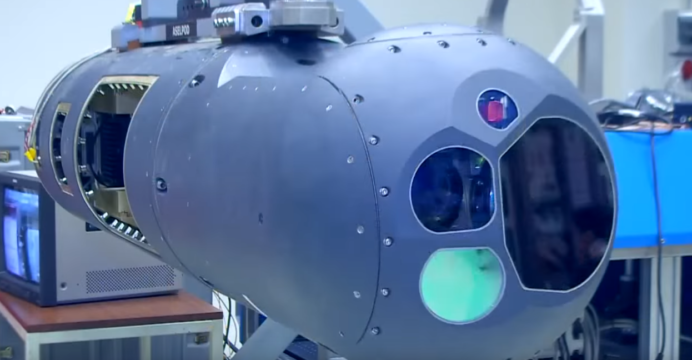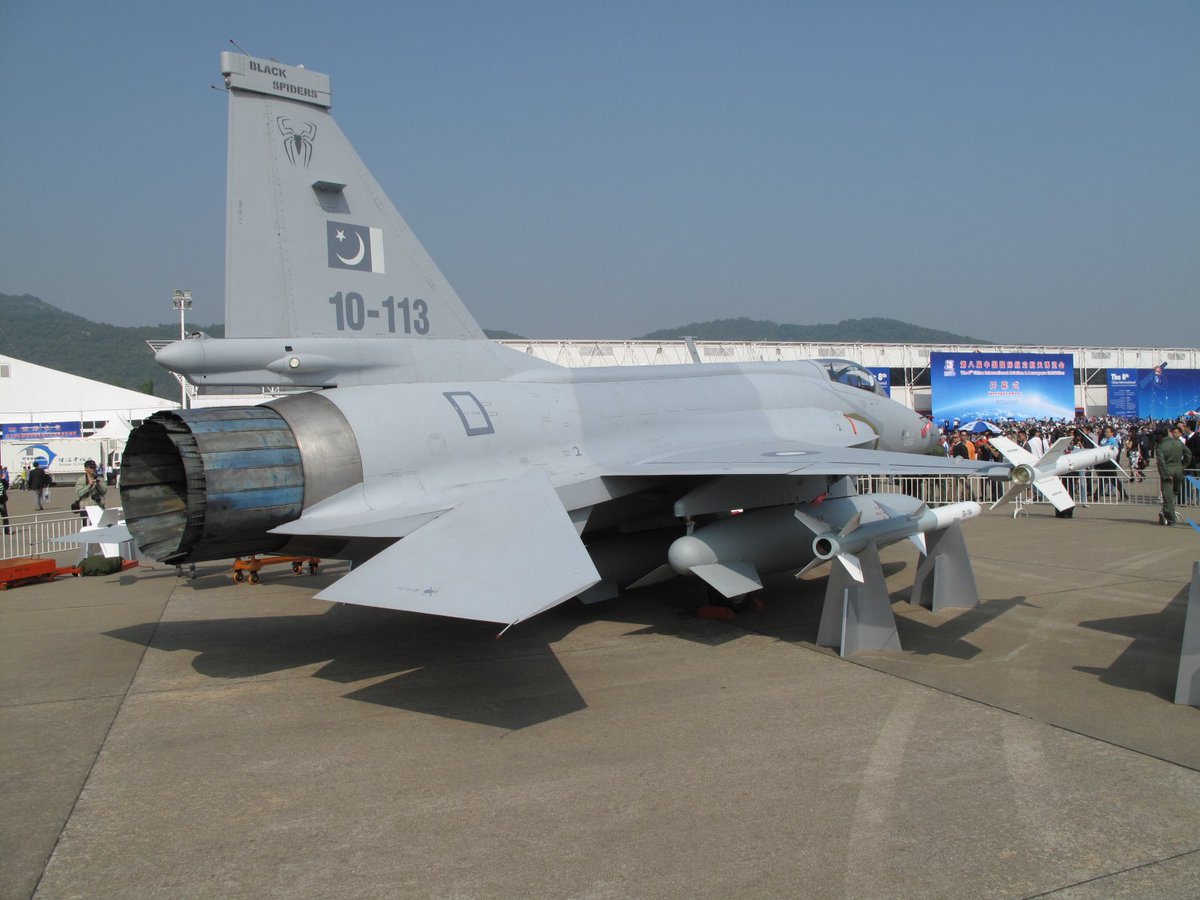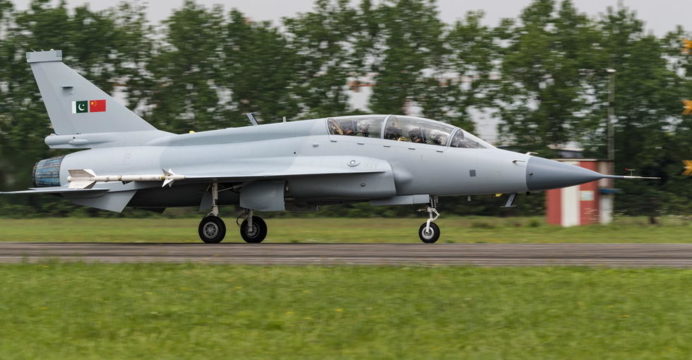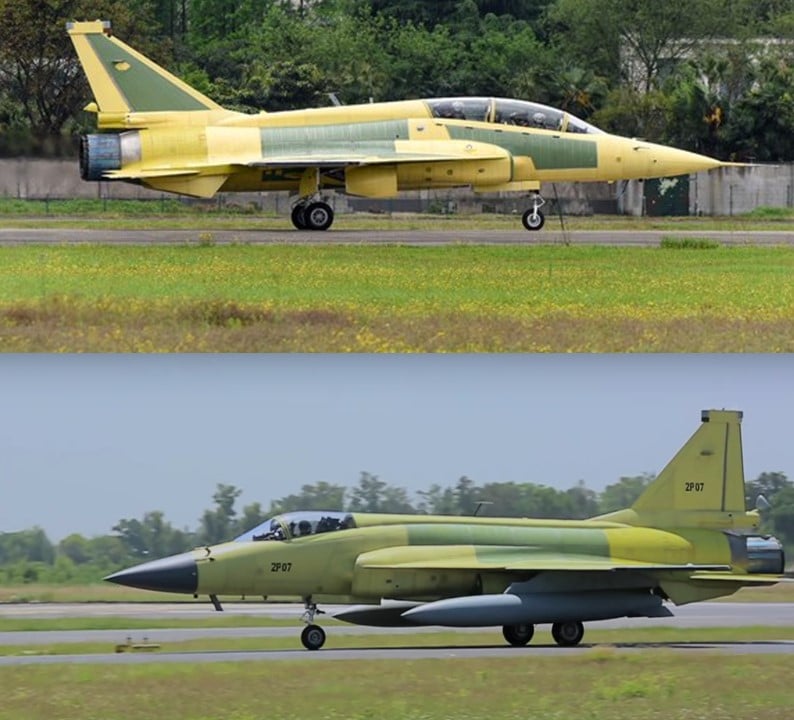THE JF-17B COULD BE THE FOUNDATION OF THE BLOCK-III
The dual-seat variant of the JF-17 – i.e. the JF-17B – conducted a successful maiden flight at Chengdu Aerospace Corporation’s (CAC) testing facility. CAC began manufacturing the JF-17B prototype last year in April; of the three prototypes planned, two will join the Pakistan Air Force (PAF). The PAF itself was satisfied with using simulators to convert its pilots to the JF-17, hence it did not plan for a twin-seater in the beginning.[1] The principal driver of the JF-17B was on improving the Thunder’s exportability, but in time, the PAF itself had expressed interest in the platform, potentially as a lead-in-fighter-trainer (LIFT).[2]
The Aviation Industry Corporation of China (AVIC) is excited about the JF-17B’s market prospects, especially as an affordable and combat-ready LIFT. The general manager of China National Aero-Technology Import and Export Corporation Yang Ying reportedly
that the JF-17B secured overseas orders before its maiden test flight. However, the excitement could be stemming from more than just the second seat – it could be a result of implementing much-anticipated improvements to the JF-17.
In its current form (i.e. Block-I and Block-II), the JF-17 is a result of the core requirements set by the PAF in the 1990s. At that time, the goal was to primarily have an affordable lightweight fighter capable of firing beyond-visual-range (BVR) air-to-air missiles (AAM) and, in turn, quickly phase-out ageing Nanchang A-5, Chengdu F-7P and Dassault Mirage III/5 fighters. The JF-17 achieved those goals: the PAF has more than 70 JF-17s in use with five squadrons – with the latest being No. 14 – and is on-track to supplanting its entire F-7P and most of its Mirage III/5 units by the end of 2019.
However, these achievements do not change the reality that the JF-17 is powered by a variant (i.e. RD-93) of the early generation Klimov RD-33 turbofan engine, which does not possess the fuel efficiency and maintenance friendliness of its modern-day counterparts, such as the RD-33MK. Nor does it alter the fact that initial builds of the JF-17’s flight control system were built using a hybrid system reliant on mechanical controls for bank and yaw (with the pitch managed electronically).[3] Wide-scale induction does not take away from the fact that initial JF-17 batches did not have enough space to store an internal electronic warfare (EW) jamming system.[4] While the JF-17 has a modern human-machine interface (HMI), one built upon a glass cockpit and hands-on-throttle-and-stick (HOTAS) system, the JF-17 does not yet benefit from a helmet-mounted display and sight (HMD/S) system. These deficiencies are major gaps relative to the JF-17’s competitors, such as the JAS-39C/D Gripen and Hindustan Aeronautics Limited (HAL) Tejas.[5]
It would be erroneous to argue that the JF-17 is not hampered by its drawbacks, but it would be equally disingenuous to argue that there were feasible and accessible alternatives. The JF-17’s baseline design – i.e. the Super-7 – was frozen at a time when Pakistan was sanctioned by the U.S., which in turn resulted in the non-delivery of 71 Lockheed Martin F-16A/B Block-15s. In the absence of accessible alternatives, the only alternate avenue for the PAF would have been to retire aging A-5s, F-7Ps and Mirage III and 5s without enough replacements, thereby causing a sharp downfall in fleet size.
The JF-17 was to return to the drawing board anyways (to accommodate for emerging technology trends – i.e. Block-III), but the cost of its absence would have been buying costlier imports. Since 18 F-16 Block-52+ cost $1.4 billion U.S., the alternative (in the 2000s and 2010s) would have, at best, been another one or two new F-16 squadrons. The PAF tried to offset the design limitations with relatively good Western subsystems and avionics, most notably from Thales, but this too fell through due to cost as well as Paris’ desire to reinforce its efforts to sell the Dassault Rafale to India.
Ultimately, the PAF proceeded with the JF-17 as-is, and successfully supplanted its A-5s, F-7Ps and Mirages. In addition, the JF-17 emerged as a credible air defence compliment to the F-16s, resulting a doubling of
and BVRAAM-capable fighters in the PAF (to 150+ fighters). It also increased the number of fighters capable of deploying stand-off range air-to-surface munitions, especially since the F-16s have yet to be equipped with such munitions. In 2015, the PAF confirmed that the JF-17 was cleared for using the C-802 anti-ship missile and Mectron MAR-1 anti-radiation missile (for engaging ground-based radars).[6] In March 2017, the PAF
the successful integration of the Global Industrial & Defence Solutions Range Extension Kit, a precision-guided glide-bomb kit (providing 50-60 km in range) for Mk-8x-series general purpose bombs.
The JF-17 was also accompanied by other important gains. Besides being a fighter the PAF could freely equip and configure, it also enabled Pakistan Aeronautical Complex (PAC) to build a strong local supply channel to support the fighter. This began with merely assembling kits from China, but by 2015, PAC was responsible for manufacturing 58% of the fighter (with AVIC providing the remaining 42% under the original workshare agreement).[7]
The local channel also enables the PAF to support the JF-17 using domestic currency and labour costs, enabling the fighter’s operational costs to be more affordable than imports. PAC is also serving a vital role in being the supplier of the JF-17’s electronics, which it is
under co-production or licensing agreements. Not only are Chinese systems being produced under license, but several Western subsystems are also being built at PAC (under co-production deals).
While the PAF opted to induct the JF-17 Block-I and Block-II, it was fully cognizant of the capabilities found on and expected of contemporary high-technology fighters. For the JF-17, the PAF may have pushed the bulk of those requirements to the
. Granted, the slated subsystems – such as the active electronically-scanned array (AESA) radar and HMD/S – would be significant upgrades, but the JF-17B seems to suggest that the Block-III will be more than just tacking new equipment to an existing design. The design itself may see several key alterations.
The swept-back vertical stabilizer of the JF-17B is housing components for a new three-axis fly-by-wire system.[8] If this is replacing the hybrid flight control system of the Block-I/II, then it may mean a reduction in weight as well as added net internal space. Interestingly, a CAC representative (Zhu Zeng) was quoted saying in 2013 that while the JF-17 Block-I was using a hybrid flight control system, CAC did have a fully digital flight control system it could develop in two years.[9] This may have been put into the JF-17B.
Externally, the JF-17B is larger than the JF-17 Block-I/II. The JF-17B has an enlarged nose to accommodate an AESA radar, but there are other airframe changes as well. AVIC’s purported JF-17B brochure states that the JF-17B’s wingspan is a half-metre longer than that of the JF-17 Block-I/II (9.5 m vs. 9.0 m[10]). It is also slightly longer than the Block-I/II (14.5 m vs. 14.26 m[11]). The lengthened wingspan may indicate an increase in payload, which is one of the JF-17 Block-III’s additions (
–
subscription required). The JF-17B airframe may also been built differently than the Block-I/II, at least in terms of materials (see below).
If this is a representation of greater composite materials usage, then this could be indicative of further weight reduction. It will be interesting to see if relaxed stability and lower wing loading were also incorporated into the design, especially with the presence of a digital fly-by-wire system. This would help improve the JF-17’s maneuverability.
The tail/engine exhaust area has also been altered, though it is unlikely that this is indicative of an engine switch at this time. The PAF did
in a new turbofan engine – the RD-33MK and WS-13. Either one of these engines would improve the JF-17’s fuel efficiency, maintenance costs, and thrust-to-weight ratio (TWR). As per Alan Warnes (via
–
subscription required), an engine switch will likely happen, though it is not known if this is slotted for the JF-17 Block-III or for later builds.
The PAF was finalizing the Block-III’s design in 2015, which was also around the time the PAF confirmed that the JF-17B will be developed and produced. Since the JF-17B itself was a new program, it is possible that the JF-17B and JF-17 Block-III are connected. Seeing the additional changes, the JF-17B is evidently a separate stream from the JF-17 Block-I/II, and it would make sense to scale the cost of developing the JF-17B to the JF-17 Block-III. Not scaling the JF-17B’s development to the Block-III would mean isolating the JF-17B as a different aircraft, which would not be cost-effective for end-users.





